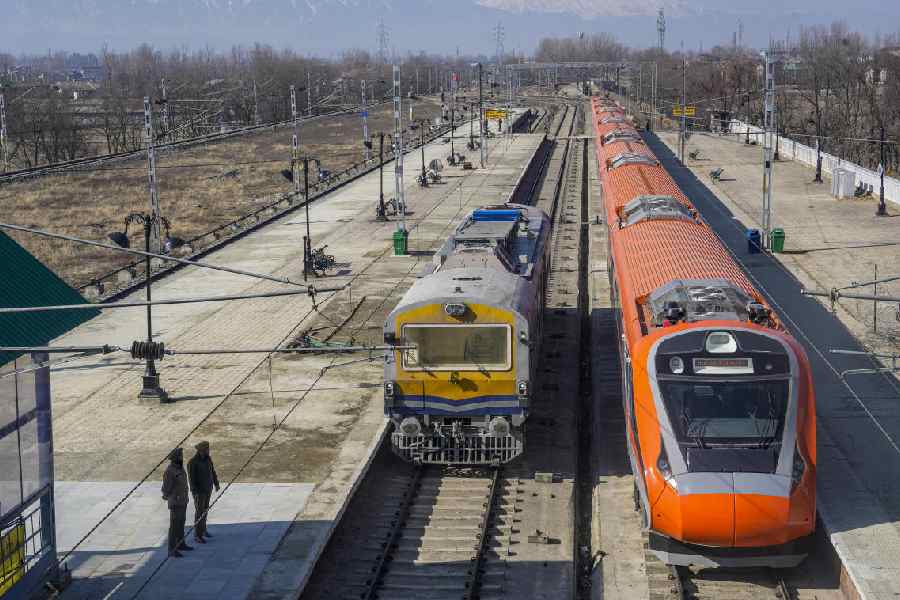 |
| Narendra Modi pays tribute to Vinayak Damodar Savarkar on his birth anniversary in Parliament on Wednesday. Picture by Ramakant Kushwaha |
New Delhi, May 28: Narendra Modi today followed in the footsteps of Atal Bihari Vajpayee, becoming the first Prime Minister since the ailing BJP patriarch to pay homage to the portrait of Vinayak Damodar Savarkar in Parliament’s Central Hall on the Hindutva icon’s birth anniversary.
The event has ritualistically raised the hackles of the non-BJP Opposition, especially the Congress.
Savarkar, the earliest known proponent of Hindutva, had been implicated in the assassination of Mohandas Gandhi but was acquitted for want of evidence.
Earlier, in 1910, he was arrested in London on charges of sedition for writing a book called The First War of Independence, 1857, shipped to India, sentenced to life imprisonment and transported to the Cellular Jail in the Andaman and Nicobar Islands where he spent 11 years in solitary confinement.
In 1937, he was elected president of the Hindu Mahasabha and remained so till his death in 1966. Although not a member of the RSS, the Sangh and later the BJP adopted Savarkar as an ideological icon and always defended his alleged complicity in Gandhi’s assassination.
Modi, who offered flowers to the portrait, later tweeted: “We remember and salute his tireless efforts towards the regeneration of our motherland.”
Most BJP MPs followed suit and paid tributes to Savarkar on his 131st birth anniversary.
It was in 2003 that the then NDA government had taken the first step towards installing Savarkar’s portrait in the Central Hall that displays gilt-edged portraits of every eminent leader associated with the Independence struggle.
The hall also has portraits of Indira Gandhi and Rajiv Gandhi. But the portraits of Prime Ministers who died after the Gandhis — V.P. Singh, Chandra Shekhar and I.K. Gujral — have not yet found a place in the august hall.
When Savarkar’s portrait was unveiled in February 2003, the non-BJP Opposition had boycotted the ceremony, except for Chandra Shekhar who was an MP. But the Congress’s response drew criticism because two of its senior leaders, incumbent President Pranab Mukherjee and Shivraj Patil, were part of the panel that had cleared the portrait proposal along with former CPM veteran Somnath Chatterjee.
Interestingly, the Left and the non-Congress bloc had written to then President A.P.J. Abdul Kalam, imploring him to stay away from the inauguration to “preserve the highest secular traditions of the country as enshrined in our Constitution”.
While Kalam unveiled the portrait, Sonia Gandhi expressed her inability to participate to “show solidarity” with the Opposition.
S. Jaipal Reddy, then a Congress spokesperson, tried to cover up for the party’s perceived wishy-washiness with a letter that said: “While Savarkar was indeed an early pioneer in the freedom movement, and spent several years of incarceration in the cellular jail at Port Blair, his petition for mercy to the British authorities, his advocacy of the two-nation theory and his alleged association with the assassins of Mahatma Gandhi make it extremely inappropriate that his portrait be put up in the same hallowed precincts which celebrate the fundamental secular and democratic values of the freedom movement and nation-building.”
The BJP was voted out in 2004, but its leaders continued to commemorate Savarkar’s birth anniversary unfailingly, despite the political isolation they suffered. Only the Lok Sabha Speaker used to be present, although every MP was invited.
The Congress’s attitude apparently pained L.K. Advani so much that in May 2011, he wrote in a blog that when Savarkar passed away, Indira Gandhi and Zakir Hussain, then the Vice-President, had eulogised him as a “classic and inspirational revolutionary” in separate tributes.
Advani noted that Vasant Sathe, the late Congress leader from Maharashtra, was the only exception to attend the anniversary event.
In 2004, five months after the BJP was tossed out of power, the UPA government ordered the removal of a plaque, enshrined with his message, from the Cellular Jail under a directive from Mani Shankar Aiyar, who was petroleum minister then. The plaque had been embedded by Ram Naik, Aiyar’s predecessor in the ministry.
Naik today called on Modi to restore the plaque.










